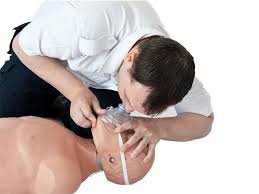BASIC LIFE SUPPORT 2015basic life support
Last updated: 6 Aug 2024 | 11102 Views |

Basic life support can be done by
made by simply Chest compressions to push blood and oxygen to vital organs, especially the brain and heart. However, in order to save lives there better quality Therefore, guidelines have been set to make it easy to follow. and increase the efficiency of patient care by dividing the line of basic assistance according to the ability of the helper as follows
1. Guidelines for the people which mainly focuses on chest compressions
2. Guidelines for people who have received additional skills training in ventilation and the use of automatic defibrillators.
3. Guidelines for medical personnel which in addition to the skills that medical personnel have such as palpation of the pulse, the use of breathing equipment, etc.
On a global scale, there is an emergency life support system for Patients with acute cardiac arrest It's a way to save lives. Most recently, in 2015, it divided patients with in-hospital cardiac arrest; IHCAs) and patients with out-of-hospital cardiac arrest (OHCAs), highlighting the following key points:
1. A universal care system (Structure-Precess-System-Outcome). knowledge and equipment), processes (Protocals policies and procedures), a system of care (planning, organizational management and organizational culture) leading to Thai people's outcomes: safety, quality, and satisfaction. An effective care system consists of the following elements: structure, process, system of care, and outcomes of care. There is a continuous evaluation and quality development system.
2. Separation of patient care into two types by location: hospital care system; and care for out-of-hospital patients For patients with out-of-hospital cardiac arrest, special community-level attention is required because in general Emergency medical interventions are often delayed (as soon as required, within 10 minutes), but in case of cardiac arrest, rescue should only be done in 3-5 minutes. If it is slower, the chance of survival is reduced. Down from 70% to less than 20%, so it depends on the community and people in the community who are aware of basic life support. will help in a timely manner including the use of defibrillators that are available in public (Public-Access Defibrillation ;PAD) until the emergency team from the Emergency Medical System (EMS) to help and take the patient to the hospital. for the doctor to diagnose and treat it further
3. The best academic evidence is reviewed. that there is a way to review the care system focusing on early cardiac arrest
The project to teach cardiac pumps and defibrillators in the community For rescuers who are the general public (Community Lay Rescuer AED Programs)
Currently, according to the 2015 Cardiopulmonary Resuscitation Guidelines, more publicly available cardioverter defibrillators and defibrillators are recommended. for Public access defibrillation (PAD programs) for patients with out-of-hospital cardiac arrest occurring in a public setting. by focusing on the place closest to the community And there is a high chance of cardiac arrest that has been seen (witnessed cardiac arrest) such as airports, train stations, sports grounds, bus stations, sub-district administrative organizations, municipalities, etc.
There is clear and consistent evidence that there is an increase in survivors of cardiac arrest. If the victim performs resuscitation and uses an automatic defibrillator quickly Therefore, immediate access to defibrillators is a key component of the patient care system. The implementation of PAD Programs requires four key components:
1) Methodical response and practice This would, in principle, include identifying locations and nearby areas at high risk of cardiac arrest. An defibrillator is installed in those areas and a notification or announcement is made to ensure that the victim can know where the device is. And there are medical personnel to support and take care of it one step further.
2) The volunteers who participated in the project were trained to perform resuscitation. and can use an automatic defibrillator
3) There is an efficient connection to the local emergency medical service system.
4) There is continuous improvement in quality.
The systematic out-of-hospital care of cardiac arrest patients also includes community policy to encourage the transfer of community-based defibrillators to Public Service Access Points (PSAPs; defibrillators). Emerging term, the EMS dispatch center is a point of contact for spectators to access public service systems, through which PSAPs can guide victims to defibrillators. nearest and can help guide the use. Whenever an out-of-hospital cardiac arrest occurs locally, provincially or nationally, Legislation to install defibrillators in government buildings Large public places such as airports, casinos, schools, because 20% of cardiac arrests in hospitals occur in public places. These community projects are therefore an important link in the chain of survival. Between recognizing acute cardiac arrest and seeking help from PSAPs
At present
There is also support for the installation of defibrillators at home. But patients with out-of-hospital cardiac arrest can occur in private places that are less likely to receive chest compressions than public cardiac arrest patients. Providing advice on resuscitation in the event of an accident (real-time) instructions) provided by emergency dispatchers may help educated and trained rescuers at home to initiate rescue. When combined with resuscitation training for people in the community. together with effective telephone guidance from the emergency response team. It can make the patient survive.

The chain of survival: essential to the survival of Thai people
Saving a patient's life is an important step. If each step is followed correctly and appropriately, it will help the patient to survive. with the following important steps:
1. Awakening the Unconscious with quick help
2. Efficient resuscitation
3. Rapid use of defibrillators.
4. The emergency medical team took over quickly and efficiently.
5. Advanced cardiopulmonary resuscitation and cardiac arrest care at the hospital
Related content
Osce-Taking history of obese babies
2 Feb 2021
Osce-Take a history of weakness
2 Feb 2021
Osce-Take a history of blurred vision
2 Feb 2021





